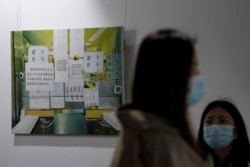Artist Yang Qian remembers many emotional times during the height of last year’s coronavirus pandemic in Wuhan, China. One memory is of seeing poorly written instructions for new patients placed on the window of a silent hospital receiving area. She also remembers watching a worker in protective clothing using strong chemicals to disinfect an empty hospital hallway.
Now, Yang is turning those memories into artwork to save the memory of Wuhan’s 76-day lockdown that changed the lives of about 11 million people.
“To express what I’ve seen in a realistic way, this is the responsibility I’ve given myself. I also hope that much of the history should not be forgotten,” she said.
Yang felt helpless in the face of an unknown virus quickly spreading through her hometown in January 2020. People in the city were fearful as officials suddenly ordered them to stay in their homes and stopped public transportation on January 23.
Two days later, Yang began volunteering with a group that took protective clothing, masks and other supplies to hospitals. Over the next four months, she and another volunteer provided about 90,000 sets of protective clothing and around 450,000 face masks.
Yang took requests from many people in the community, giving them much needed supplies, from medicine and disinfectant to food. She did not sleep much because the work often went into the early hours of the morning.
Her first post-pandemic artwork was called “Reception.” The idea came from her experience of going with a mother and daughter to a hospital in early February. The two had developed signs of COVID-19 after the father died at home from the disease. The mother and daughter then asked for help on social media.
Yang saw their message and found a hospital willing to accept them. But she was told that no emergency vehicles were available.
With public transportation closed, the only solution was to bicycle to the hospital, with Yang leading the way.
When they arrived, Yang saw instructions for new patients attached to a window. Some of the instructions were written by hand. Hospital workers would point to the window instead of answering questions.
Yang carefully reproduced the event in an oil painting.
A second oil painting with deep blue and black colors followed. It was based on a picture of a worker disinfecting a hospital hallway.
“It is in such a severe situation, (but) even in this atmosphere, there are still people who stand up for us and protect us,” Yang said.
Soon after sending the mother and daughter to the hospital, Yang developed a high temperature and cough and feared she had the coronavirus. She went to a hospital to get tested and began writing her will. After what she calls the longest hour of her life while waiting for the results, she was told she did not have COVID-19.
A year later, Wuhan has largely returned to normal. Its streets and stores are filled. Others stay out all night dancing. Only the face masks people wear suggest the pandemic’s lasting effects.
“What I see is the unity of our city, our nation. I find that I am really very proud of being a Chinese,” Yang said.
An art show she organized last year brought together 23 artists with 60 pieces of artwork related to the coronavirus.
Wuhan media and citizens have praised Yang’s efforts. A friend of Yang’s, businessman Michael Liu, said the show “crystallized every touching moment of the pandemic.”
“Unifying art and thoughts, and taking action, is something that many of us cannot do,” he added.
Yang is currently working on a wall-size aerial image of Wuhan under lockdown. Individual citizens are represented by small black dots. It is an expression of their unity in surviving the crisis, as well as unseen pain.
Yang still feels that pain when speaking with locals and survivors who have suffered emotionally or moved away from social life.
“Some people are slowly trying to recover, just to come out of this shadow. Then there are some who can’t get out, because this virus and disaster really took away those closest to them,” Yang said.
I’m Jonathan Evans.
Emily Wang Fujiyama reported on this story for the Associated Press. Jonathan Evans adapted this story for Learning English. Bryan Lynn was the editor.
_______________________________________________________________
Words in This Story
disinfect – v. to kill germs with chemicals
lockdown – n. an emergency situation in which people are not permitted to freely leave a restricted area
mask – v. a covering used to hide or protect your face
proud – adj. very happy and pleased because of something you have done, something you own, someone you know or are related to, etc.
crystallize – v. to make clear and fixed
aerial – adj. in or from the air, especially from an aircraft
shadow – n. a dark shape that appears on a surface when someone or something moves between the surface and a source of light









